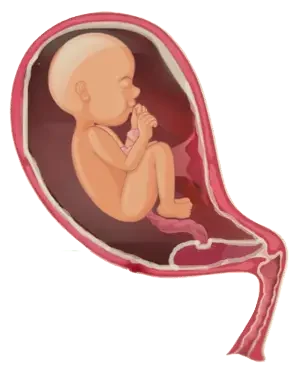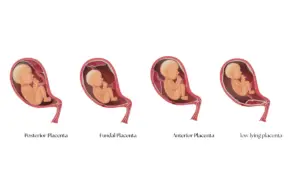We spend a lot of time discussing the strength of the placenta and the health benefits it gives both before and after labor. Why? Because it is powerful!
The placenta is the organ that transfers nutrition and oxygen to your baby during pregnancy. It’s essential for your baby’s development and a healthy pregnancy.
Your baby’s placenta develops alongside him. However, many mothers are unaware that it can become attached at multiple locations in the uterus. Furthermore, the position of the placenta in the uterus can influence the ease of your labor and baby’s birth.
In this post, we will go over the development of the placenta and address the question: which placenta position is ideal for normal delivery?
What Is The Placenta?
The placenta is a short-term organ that forms in the uterus during pregnancy. It connects the baby to the mother’s blood supply via the umbilical cord, allowing the exchange of oxygen, nutrition, antibodies, and hormones while preventing the mixing of maternal and fetal blood. It also eliminates CO2 and waste materials from the baby’s bloodstream.
By about 12 weeks of pregnancy, the placenta has fully developed. By the time it arrives, it is roughly 10 inches in diameter and 1 inch thick, resembling a flat pancake. Even though it only lasts nine months, it has a long-term impact on the baby’s health and development.
How Is the Placental Position Determined?
- posterior (back wall)
- Anterior (front wall)
- Fundal (top of uterus)
- Lateral (right or left side)
- Low-lying (near or above the cervix)
Which Placental Position Is Best for Normal Delivery?
The posterior placenta is widely regarded as the optimal placental position for normal delivery. This positioning indicates that the placenta is linked to the uterine back wall, allowing the baby to arrange itself optimally—head down and facing the mother’s back.
With the posterior placenta, the baby’s back rests against the mother’s tummy, allowing for a more efficient and comfortable labor. This position also makes fetal movements easier to detect and facilitates a smoother descent into the delivery canal.
Posterior placental position = Ideal for normal vaginal birth
Other Placental Positions and Their Effect on Delivery
Anterior placenta
The placenta is located in the front of the uterus, between the fetus and the abdominal wall. This is the most typical arrangement.
Impact→ Baby movements may be harder to detect. The baby may end positioned facing the mother’s spine, resulting in “back labor,” which is typically more intense.
Vaginal delivery is usually still possible, however labor may take longer or be more unpleasant.
Risks→ May modestly increase the likelihood of induction, cesarean section, or postpartum problems.
Low-lying placenta (Placenta Previa)
The placenta is positioned close or over the cervix.
Impact→ Obstructs the baby’s path during birth, increasing the risk of bleeding.
Delivery→ If the placenta does not travel upward by the third trimester, a cesarean section will be necessary.
Risk→ Placenta previa affects around one in every 200 pregnancies.
Fundal placenta
The placenta is found at the top of the uterus.
Impact→ Frequently creates no problems. However, because the top of the uterus is the thinnest, there is a little higher risk of membrane rupture.
Delivery→ Vaginal delivery is frequently possible. However, several studies have connected fundal placentation to an increased risk of premature birth and manual placenta removal.
Risks include→ premature membrane rupture and a shorter third stage of labor.
Lateral placenta
The placenta attaches to either the right or left side of the uterus.
Impact→ This is a less typical position. It may at times disrupt uniform blood flow and has been linked to increased risks such as intrauterine growth restriction (IUGR), low Apgar scores, and preeclampsia.
Delivery→ Normal delivery is still possible, but it may necessitate more frequent monitoring.
Can the placenta shift its position during pregnancy?
Yes, particularly in early and mid-pregnancy. Many women who are identified with a low-lying placenta at their 20-week ultrasound discover that by week 32 or later, the placenta has moved upward as the uterus expands. This spontaneous “migration” can turn a potentially problematic positioning into a favorable one for vaginal birth.
Factors That Can Influence Placental Position
Though the exact reasons are unknown, some factors that could influence where the placenta attaches include:
- Maternal sleep posture (e.g., sleeping on the back has been associated with anterior placentation)
- Blood Pressure
- Blood type (for example, posterior placentas have been associated to A-positive blood type and anterior to O-positive)
- Previous uterus operations or cesarean sections
- Multiple pregnancies
Can Maternal Habits Influence Placenta Location?
Maternal sleep habits and blood pressure may impact placenta location. A study found:
- Back sleepers had a higher chance of having an anterior placenta
- Stomach sleepers had a higher chance of having a posterior placenta
- Right-side sleepers had a higher chance of having a lateral placement
- Left-side sleepers had a higher chance of having a fundal placentation, higher maternal blood pressure was linked to fundal placements
Summary: Which Placenta Position is Ideal for Normal Delivery?
To summarize, the posterior placenta is best suited for a normal vaginal birth. It allows the baby to settle into the best birthing position, which usually results in a gentler labor. Most placental placements, with the exception of low-lying ones, can nevertheless support a safe, healthy birth if properly cared for and monitored.
If you’re wondering whether placenta position is suitable for a normal delivery, rest assured that your healthcare professional will monitor your placenta and advise you on what’s best for you and your baby.



















